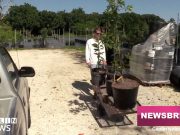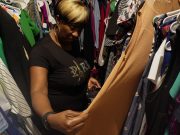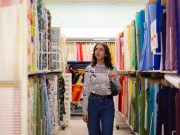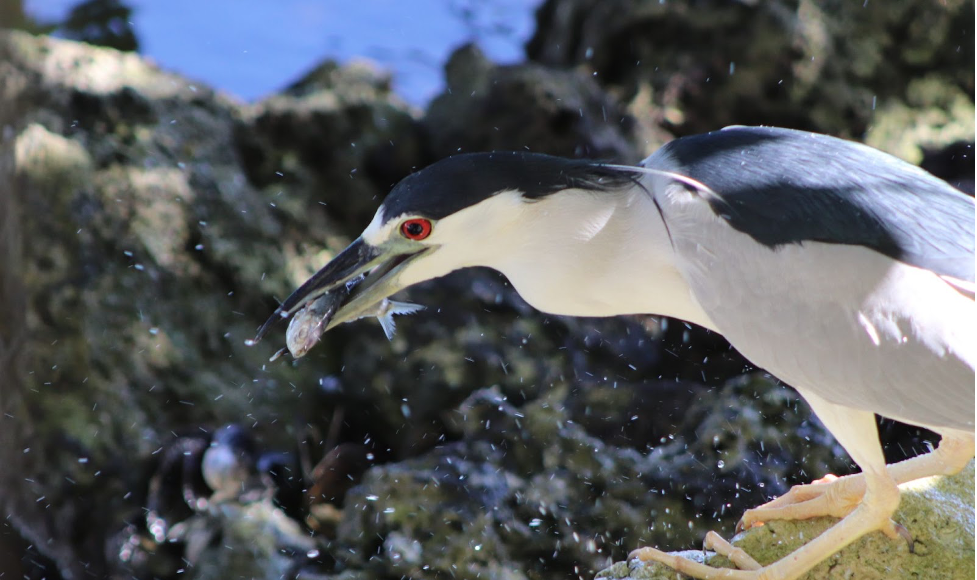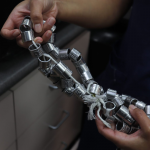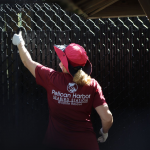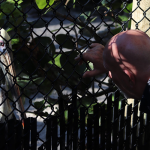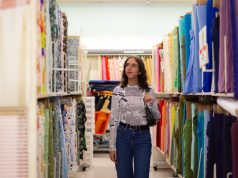A volunteer hauls in a large delivery box, its flaps barely open. Evelyn Hilliker, a wildlife rehabilitator, pulls out a baby Eastern Screech Owl covered in sawdust from the box.
After staff checks out the bird, they move it to a nesting box so its mom can find it and continue nursing.

A man brought the owl to Pelican Harbor Seabird Station after the tree that was its home was cut down. The baby weighs 83.5 grams, about average.
On a recent day, Evelyn Hilliker, a seasonal wildlife rehabilitator, prepares to give the baby fluids and Vitamin B complex subcutaneously. While people receive fluids through IVs that go through tissue and muscle, this little owl receives them through a needle Hilliker inserts into the paper-thin skin near its spine.
“I generally try to use the smallest needle that we can for their skin and for the medication that they’re doing to minimize pain,” said Hilliker.
The baby screech owl is just one of the 2,300 patients treated by the seabird station on the 79th Street Causeway in Miami every year. Their goal is to rehabilitate them and release them back into the wild.
If their injuries prevent them from surviving in nature, they become animal ambassadors that help the rehabilitation center teach the public about South Florida’s wildlife.

Basil, a one-eyed opossum, is another kind of ambassador. He helps the center break the stigma surrounding America’s only native marsupial.
Opossums scare people who don’t know much about them. But the nocturnal creatures contribute much to the environment. Not only do they keep the tick population controlled, but they also eat cockroaches, rats and mice. They’re resistant to snake venom and will eat serpents, too.
“It’s a very polarizing animal,” said Hannah McDougall, the communications director.
Basil’s right eye is damaged, but she lives a comfortable life. She’s been at the sanctuary for two years and is a part of the rehabilitation center’s Adopt-a-Possum program.
“For some reason, she kept getting infections in her eye,” said Jill Szymanski, a volunteer with Pelican Harbor. “She had surgeries, but she never recovered her eyesight.”
Members of the public can symbolically adopt the orphaned opossum. According to their website, someone who is willing to donate $75 will receive a photograph of Basil, a certificate of adoption, “the honor of knowing you’ve helped to feed an Opossum for a year,” and more.
The public can also tune into Pelican Harbor’s live Pelicam to watch the station’s five permanent pelican residents in their enclosure. People can watch the live stream on their YouTube channel.

Staff and volunteers are also on egg watch. Two of the birds are nesting and watching over an egg. If the egg hatches and the chick reaches adulthood, it will be released into the wild once it no longer needs its parents.
Volunteers are usually allowed to go into their pen to hand feed them or give them water. But because of the egg, they’re trying to limit the contact the five pelicans have with humans to ensure the parents are stress-free.
Like Basil, the pelicans received injuries that prevented them from surviving in the wild. The four Brown Pelicans share a pen with Monroe, an American white Pelican, and are at the heart of Pelican Habor’s mission.
The Brown pelicans are an indicator species, and it’s crucial to track their populations.
“The health of their population is an indication of the overall health of the environment,” said McDougall.
Injured pelicans and other animals that graduated from the clinic are moved to the pens outside before being set back in the wild. Unlike the permanent residents, volunteers and staff aren’t allowed to hand-feed or pet them. This prevents the animals from becoming too friendly with humans.
While Pelican Harbor rehabilitates different native species, they are licensed to tag pelicans. This helps track pelicans’ medical histories and flight patterns.
The seabird station encourages people who find injured wildlife to call them. They have volunteers willing to drive out and pick up the injured animals. The center can also send Ubers to pick up South Florida’s fallen fauna.
Ubers drop off around 10% of the birds that come into the wildlife center, said McDougall.
Pelican Harbor’s website lists safe ways for people to capture hurt animals. But they don’t encourage people who aren’t comfortable with it to trap the harmed critters. The center asks the public to call 305-751-9840 and text a photo to 786-459-9155 before bringing in any animal.
The station is only able to treat native species. Stray dogs and cats, as well as any non-native species, will be turned away.
Anyone who wishes to help the sanctuary can donate cash or cryptocurrency. People can purchase items from their Amazon wish-list to donate the things Pelican Harbor needs, too.
They also accept old newspapers. They use it to line the bottom of the cages in the clinic and always need more.


